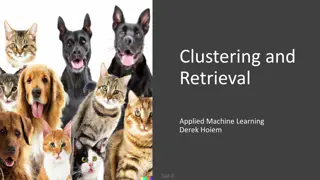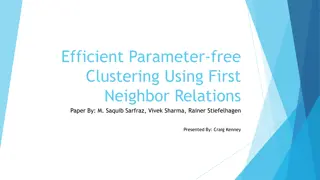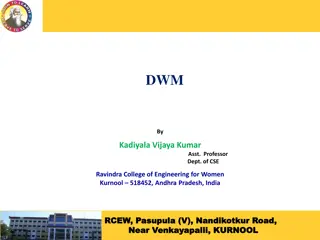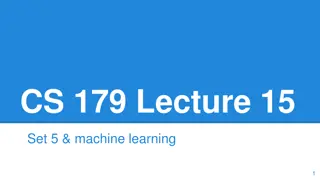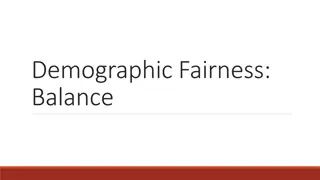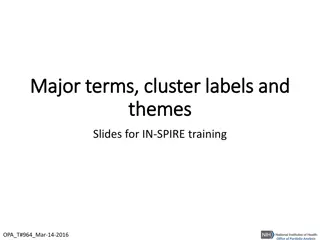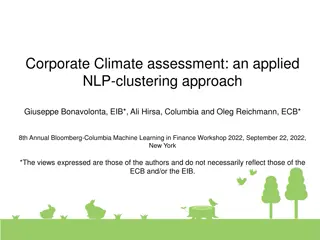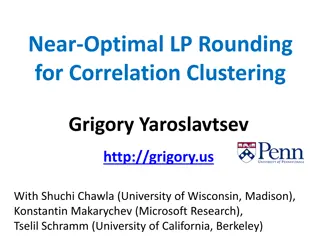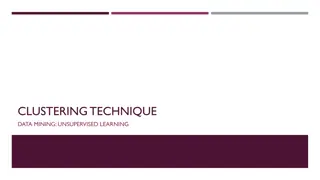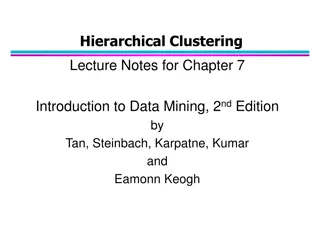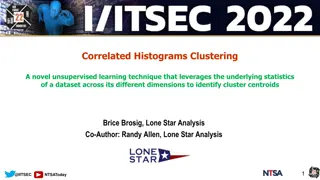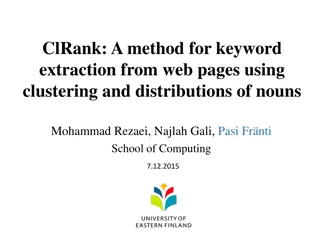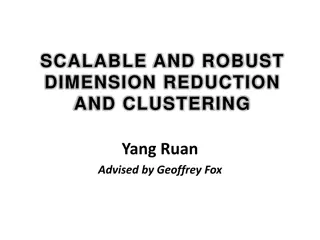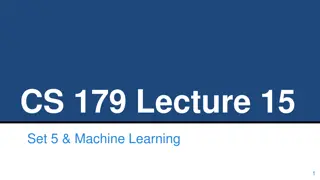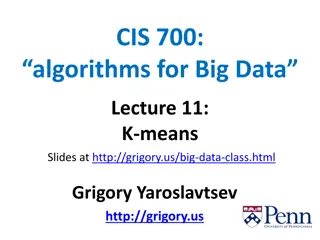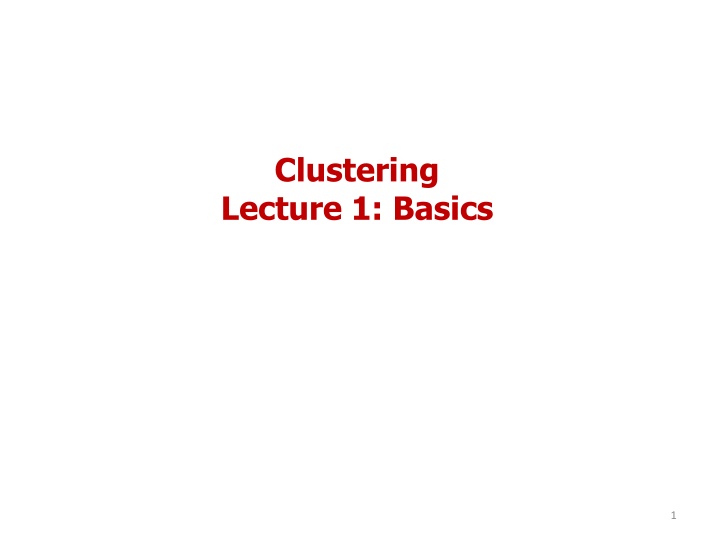
Comprehensive Introduction to Clustering Techniques and Applications
Explore the basics of clustering, including motivation, methods, evaluation, and application examples. Delve into gene-based clustering for co-expressed genes and coherent patterns in gene expression data. Learn how clustering is utilized in various domains such as market research and pattern recognition.
Download Presentation

Please find below an Image/Link to download the presentation.
The content on the website is provided AS IS for your information and personal use only. It may not be sold, licensed, or shared on other websites without obtaining consent from the author. If you encounter any issues during the download, it is possible that the publisher has removed the file from their server.
You are allowed to download the files provided on this website for personal or commercial use, subject to the condition that they are used lawfully. All files are the property of their respective owners.
The content on the website is provided AS IS for your information and personal use only. It may not be sold, licensed, or shared on other websites without obtaining consent from the author.
E N D
Presentation Transcript
Clustering Lecture 1: Basics 1
Outline Basics Motivation, definition, evaluation Methods Partitional Hierarchical Density-based Mixture model Spectral methods Advanced topics Clustering in MapReduce Clustering ensemble Semi-supervised clustering, subspace clustering, co-clustering, etc. 2
Readings Tan, Steinbach, Kumar, Chapters 8 and 9. Han, Kamber, Pei. Data Mining: Concepts and Techniques. Chapters 10 and 11. Additional readings posted on website 3
Clustering Basics Definition and Motivation Data Preprocessing and Similarity Computation Objective of Clustering Clustering Evaluation 4
Clustering Finding groups of objects such that the objects in a group will be similar (or related) to one another and different from (or unrelated to) the objects in other groups Inter-cluster distances are maximized Intra-cluster distances are minimized 5
Application Examples A stand-alone tool: explore data distribution A preprocessing step for other algorithms Pattern recognition, spatial data analysis, image processing, market research, WWW, Cluster documents Cluster web log data to discover groups of similar access patterns 6
Clustering Co-expressed Genes Gene Expression Data Matrix Gene Expression Patterns Co-expressed Genes Why looking for co-expressed genes? Co-expression indicates co-function; Co-expression also indicates co-regulation. 7
Gene-based Clustering 1.5 1 0.5 Expression Value 0 -0.5 -1 -1.5 Time Point 1.5 1 0.5 Expression Level 0 -0.5 -1 -1.5 Time Points 1.5 1 0.5 Expression Value 0 -0.5 -1 -1.5 Time Points Examples of co-expressed genes and coherent patterns in gene expression data Iyer s data [2] [2] Iyer, V.R. et al. The transcriptional program in the response of human fibroblasts to serum. Science, 283:83 87, 1999. 8
Other Applications Marketing: Help marketers discover distinct groups in their customer bases, and then use this knowledge to develop targeted marketing programs City-planning: Identifying groups of houses according to their house type, value, and geographical location Climate: understanding earth climate, find patterns of atmosphere and ocean 9
Two Important Aspects Properties of input data Define the similarity or dissimilarity between points Requirement of clustering Define the objective and methodology 10
Clustering Basics Definition and Motivation Data Preprocessing and Distance computation Objective of Clustering Clustering Evaluation 11
Data Representation Data: Collection of data objects and their attributes Attributes Tid Refund Marital Taxable Income Cheat An attribute is a property or characteristic of an object Examples: eye color of a person, temperature, etc. Attribute is also known as dimension, variable, field, characteristic, or feature Status 1 Yes Single 125K No 2 No Married 100K No 3 No Single 70K No 4 Yes Married 120K No 5 No Divorced 95K Yes Objects 6 No Married 60K No 7 Yes Divorced 220K No A collection of attributes describe an object Object is also known as record, point, case, sample, entity, or instance 8 No Single 85K Yes 9 No Married 75K No 10 No Single 90K Yes 10 12
Data Matrix Represents n objects with p attributes An n by p matrix The value of the i-th object on the f-th attribute Attributes x x x 11 1 1 f p Objects ix x x 1 if ip x x x 1 n nf np 13
Gene Expression Data Clustering genes condition 1 condition 2 condition 3 condition 4 condition gene 1 0.13 0.72 0.1 0.57 Genes are objects gene 2 0.34 1.58 1.05 1.15 Experiment conditions are attributes gene 3 0.43 1.1 0.97 1 gene 4 1.22 0.97 1 0.85 Find genes with similar behavior gene 5 -0.89 1.21 1.29 1.08 gene 6 1.1 1.45 1.44 1.12 gene 7 0.83 1.15 1.1 1 gene 8 0.87 1.32 1.35 1.13 gene 9 -0.33 1.01 1.38 1.21 gene 10 0.10 0.85 1.03 1 gene 14
Similarity and Dissimilarity Similarity Numerical measure of how alike two data objects are Is higher when objects are more alike Often falls in the range [0,1] Dissimilarity Numerical measure of how different are two data objects Lower when objects are more alike Minimum dissimilarity is often 0 Upper limit varies 15
Types of Attributes Discrete Has only a finite or countably infinite set of values Examples: zip codes, counts, or the set of words in a collection of documents Note: binary attributes are a special case of discrete attributes Ordinal Has only a finite or countably infinite set of values Order of values is important Examples: rankings (e.g., pain level 1-10), grades (A, B, C, D) Continuous Has real numbers as attribute values Examples: temperature, height, or weight Continuous attributes are typically represented as floating-point variables 16
Similarity/Dissimilarity for Simple Attributes p and q are the attribute values for two data objects. Discrete Ordinal Continuous Dissimilarity and similarity between p and q 17
Distance Matrix Represents pairwise distance in n objects An n by n matrix d(i,j): distance or dissimilarity between objects i and j Nonnegative Close to 0: similar 0 (2,1) 0 d (3,1) (3,2) 0 d d n n ( ,1) ( ,2) 0 d d 18
Data Matrix -> Distance Matrix s 1 s 2 s 3 s 4 g 1 0.13 0.72 0.1 0.57 g 1 g 2 g 3 g 4 g 2 0.34 1.58 1.05 1.15 g 1 0 d(1,2) d(1,3) d(1,4) g 3 0.43 1.1 0.97 1 g 4 1.22 0.97 1 0.85 g 2 0 d(2,3) d(2,4) g 5 -0.89 1.21 1.29 1.08 g 3 0 d(3,4) g 6 1.1 1.45 1.44 1.12 g 7 0.83 1.15 1.1 1 g 4 0 g 8 0.87 1.32 1.35 1.13 g 9 -0.33 1.01 1.38 1.21 g 10 0.10 0.85 1.03 1 Distance Matrix Original Data Matrix 19
Minkowski DistanceContinuous Attribute Minkowski distance: a generalization q q q q = + + + ) 0 , ( i d ) | | | | ... | | ( j x x x x x x q i j i j i j 1 1 2 2 p p If q = 2, d is Euclidean distance If q = 1, d is Manhattan distance xi Xi (1,7) 12 8.48 q=2 6 q=1 6 xj Xj(7,1) 20
Standardization Calculate the mean absolute deviation f n 1 = + m (x x x + + ... . ) 1 2 f f nf 1 n = + + + (| | | | ... | |) s x m x m x m 1 2 f f f f f nf f Calculate the standardized measurement (z-score) x m = if f z s if f 21
Mahalanobis Distance = 1 T ( , ) ( ) ( ) d p q p q p q is the covariance matrix of the input data X n 1 = i = ( )( ) X X X X j k , j k ij ik 1 n 1 For red points, the Euclidean distance is 14.7, Mahalanobis distance is 6. 22
Mahalanobis Distance Covariance Matrix: 3 . 0 2 . 0 = 2 . 0 3 . 0 C A: (0.5, 0.5) B B: (0, 1) A C: (1.5, 1.5) Mahal(A,B) = 5 Mahal(A,C) = 4 23
Common Properties of a Distance Distances, such as the Euclidean distance, have some well known properties d(p, q) 0 for all p and q and d(p, q) = 0 only if p= q. (Positive definiteness) d(p, q) = d(q, p) for all p and q. (Symmetry) d(p, r) d(p, q) + d(q, r) for all points p, q, and r. (Triangle Inequality) where d(p, q) is the distance (dissimilarity) between points (data objects), p and q. 1. 2. 3. A distance that satisfies these properties is a metric 24
Similarity for Binary Attributes Common situation is that objects, p and q, have only binary attributes Compute similarities using the following quantities M01 = the number of attributes where p was 0 and q was 1 M10 = the number of attributes where p was 1 and q was 0 M00 = the number of attributes where p was 0 and q was 0 M11 = the number of attributes where p was 1 and q was 1 Simple Matching and Jaccard Coefficients SMC = number of matches / total number of attributes = (M11 + M00) / (M01 + M10 + M11 + M00) J = number of matches / number of not-both-zero attributes values = (M11) / (M01 + M10 + M11) 25
SMC versus Jaccard: Example p = 1 0 0 0 0 0 0 0 0 0 q = 0 0 0 0 0 0 1 0 0 1 M01 = 2 (the number of attributes where p was 0 and q was 1) M10 = 1 (the number of attributes where p was 1 and q was 0) M00 = 7 (the number of attributes where p was 0 and q was 0) M11 = 0 (the number of attributes where p was 1 and q was 1) SMC = (M11 + M00)/(M01 + M10 + M11 + M00) = (0+7) / (2+1+0+7) = 0.7 J = (M11) / (M01 + M10 + M11) = 0 / (2 + 1 + 0) = 0 26
Document Data Each document becomes a `term' vector, each term is a component (attribute) of the vector, the value of each component is the number of times the corresponding term occurs in the document. timeout season coach game score team ball lost pla wi n y Document 1 3 0 5 0 2 6 0 2 0 2 Document 2 0 7 0 2 1 0 0 3 0 0 Document 3 0 1 0 0 1 2 2 0 3 0 27
Cosine Similarity If d1 and d2 are two document vectors, then cos( d1, d2 ) = (d1 d2) / ||d1|| ||d2|| , where indicates vector dot product and || d || is the length of vector d. Example: d1= 3 2 0 5 0 0 0 2 0 0 d2 = 1 0 0 0 0 0 0 1 0 2 d1 d2= 3*1 + 2*0 + 0*0 + 5*0 + 0*0 + 0*0 + 0*0 + 2*1 + 0*0 + 0*2 = 5 ||d1|| = (3*3+2*2+0*0+5*5+0*0+0*0+0*0+2*2+0*0+0*0)0.5 = (42) 0.5 = 6.481 ||d2|| = (1*1+0*0+0*0+0*0+0*0+0*0+0*0+1*1+0*0+2*2)0.5= (6) 0.5 = 2.245 cos( d1, d2 ) = .3150 28
Correlation Correlation measures the linear relationship between objects To compute correlation, we standardize data objects, p and q, and then take their dot product (continuous attributes) k = ( ( )) / ( ) p p mean p std p k k = ( ( )) / ( ) q q mean q std q k = ( , ) s p q p q 29
Common Properties of a Similarity Similarities, also have some well known properties. 1. s(p, q) = 1 (or maximum similarity) only if p= q. 2. s(p, q) = s(q, p) for all p and q. (Symmetry) where s(p, q) is the similarity between points (data objects), p and q. 30
Characteristics of the Input Data Are Important Sparseness Attribute type Type of Data Dimensionality Noise and Outliers Type of Distribution => Conduct preprocessing and select the appropriate dissimilarity or similarity measure => Determine the objective of clustering and choose the appropriate method 31
Clustering Basics Definition and Motivation Data Preprocessing and Distance computation Objective of Clustering Clustering Evaluation 32
Considerations for Cluster Analysis Partitioning criteria Single level vs. hierarchical partitioning (often, multi-level hierarchical partitioning is desirable) Separation of clusters Exclusive (e.g., one customer belongs to only one region) vs. overlapping (e.g., one document may belong to more than one topic) Hard versus fuzzy In fuzzy clustering, a point belongs to every cluster with some weight between 0 and 1 Weights must sum to 1 Probabilistic clustering has similar characteristics Similarity measure and data types Heterogeneous versus homogeneous Cluster of widely different sizes, shapes, and densities 33
Requirements of Clustering Scalability Ability to deal with different types of attributes Minimal requirements for domain knowledge to determine input parameters Able to deal with noise and outliers Discovery of clusters with arbitrary shape Insensitive to order of input records High dimensionality Incorporation of user-specified constraints Interpretability and usability What clustering results we want to get? 34
Notion of a Cluster can be Ambiguous How many clusters? Six Clusters Two Clusters Four Clusters 35
Partitional Clustering Input Data A Partitional Clustering 36
Hierarchical Clustering p1 p3 p4 p2 p1 p2 p3 p4 Clustering Solution 1 p1 p3 p4 p2 p1 p2 p3 p4 Clustering Solution 2 37
Types of Clusters: Center-Based Center-based A cluster is a set of objects such that an object in a cluster is closer (more similar) to the center of a cluster, than to the center of any other cluster The center of a cluster is often a centroid, the average of all the points in the cluster, or a medoid, the most representative point of a cluster 4 center-based clusters 38
Types of Clusters: Density-Based Density-based A cluster is a dense region of points, which is separated by low- density regions, from other regions of high density. Used when the clusters are irregular or intertwined, and when noise and outliers are present. 6 density-based clusters 39
Clustering Basics Definition and Motivation Data Preprocessing and Distance computation Objective of Clustering Clustering Evaluation 40
Cluster Validation Cluster validation Quality: goodness of clusters Assess the quality and reliability of clustering results Why validation? To avoid finding clusters formed by chance To compare clustering algorithms To choose clustering parameters e.g., the number of clusters 41
Aspects of Cluster Validation Comparing the clustering results to ground truth (externally known results) External Index Evaluating the quality of clusters without reference to external information Use only the data Internal Index Determining the reliability of clusters To what confidence level, the clusters are not formed by chance Statistical framework 42
Comparing to Ground Truth Notation N: number of objects in the data set P={P1, ,Ps}: the set of ground truth clusters C={C1, ,Ct}: the set of clusters reported by a clustering algorithm The incidence matrix N N (both rows and columns correspond to objects) Pij= 1 if Oi and Ojbelong to the same ground truth cluster in P; Pij=0 otherwise Cij = 1 if Oi and Oj belong to the same cluster in C; Cij=0 otherwise 43
Rand Index and Jaccard Coefficient A pair of data object (Oi,Oj) falls into one of the following categories SS: Cij=1 and Pij=1; DD: Cij=0 and Pij=0; SD: Cij=1 and Pij=0; DS: Cij=0 and Pij=1; (agree) (agree) (disagree) (disagree) + | | | | | | Agree + SS DD Rand index = = Rand + + + | | | | | | | | | | | | Agree Disagree SS SD DS DD may be dominated by DD Jaccard Coefficient | | SS = Jaccard coefficien t + + | | | | | | SS SD DS 44
Clustering g 1 g 2 g 3 g 4 g 5 g 1 1 1 1 0 0 g 2 1 1 1 0 0 Clustering g 3 1 1 1 0 0 Same Cluster Different Cluster Ground truth g 4 0 0 0 1 1 Same Cluster Different Cluster 9 4 g 5 0 0 0 1 1 4 8 Groundtruth g 1 g 2 g 3 g 4 g 5 + | | | | 17 SS DD = = Rand g 1 1 1 0 0 0 + + + | | | | | | | | 25 SS SD DS DD g 2 1 1 0 0 0 g 3 0 0 1 1 1 | | 9 SS = = Jaccard + + | | | | | | 17 SS SD DS g 4 0 0 1 1 1 g 5 0 0 1 1 1 45
Entropy and Purity Notation the number of objects in both the k-th cluster of the clustering solution and j-th cluster of the groundtruth the number of objects in the k-th cluster of the clustering solution the number of objects in the j-th cluster of the groundtruth C | | P k j | | C k | | jP 1 k Purity = max | | Purity C P j k j N Normalized Mutual Information | | | C | C P N C P = k j k j ( , ) I C P ( , ) log I C P NMI = | || | N P k j ( ) ( ) k j H C H P | | | | C C | | | | P P = C ( ) log k k H j j = ( ) log H P N N N N k j 46
Example P 1 P 2 P 3 P 4 P5 P6 Total C1 3 5 40 506 96 27 677 1 C 2 4 7 280 29 39 2 361 k = max | | Purity C P j k j N C 3 1 1 1 7 4 671 685 + + + + + 506 280 671 162 331 358 = C 4 10 162 3 119 73 2 369 Purity 3204 = . 0 7203 C 5 331 22 5 70 13 23 464 C 6 5 358 12 212 48 13 648 total 354 555 341 943 273 738 3204 | | | C | C P N C P ( , ) I C P = k j k j ( , ) log I C P NMI = | || | N P ( ) ( ) H C H P k j k j | | | | C C | | | | P P = C ( ) log k k H j j = ( ) log H P N N N N k 47 j
Internal Index Ground truth may be unavailable Use only the data to measure cluster quality Measure the cohesion and separation of clusters Calculate the correlation between clustering results and distance matrix 48
Cohesion and Separation Cohesion is measured by the within cluster sum of squares i C x i = 2) ( WSS x m i Separation is measured by the between cluster sum of squares i = 2) ( BSS C m m i i where |Ci| is the size of cluster i, m is the centroid of the whole data set BSS + WSS = constant WSS (Cohesion) measure is called Sum of Squared Error (SSE) a commonly used measure A larger number of clusters tend to result in smaller SSE 49
Example m m1 m2 1 2 3 4 5 = 2 ( + 4 ( + + = 2 2 2 2 1 ( ) 3 ) 3 ) 3 5 ( ) 3 10 WSS K=1 : = 3 ( = 2 4 = ) 3 = 0 BSS + 10 0 10 Total = ) 5 . 1 2 ( + ) 5 . 1 4 ( + 5 ( + ) 5 . 4 = 2 2 2 2 1 ( ) 5 . 4 = 1 WSS K=2 : = + 5 . 4 ( ) 3 2 2 2 = 3 ( + ) 5 . 1 = 2 9 BSS 1 9 10 Total K=4: = ) 1 2 ( + ) 2 4 ( + 5 ( + ) 5 = 2 2 2 2 1 ( ) 4 + 0 WSS = ) 3 + 2 ( ) 3 4 ( ) 3 + 5 ( ) 3 = 2 2 2 2 1 = 1 ( + 1 1 1 10 BSS = 0 10 10 Total 50

